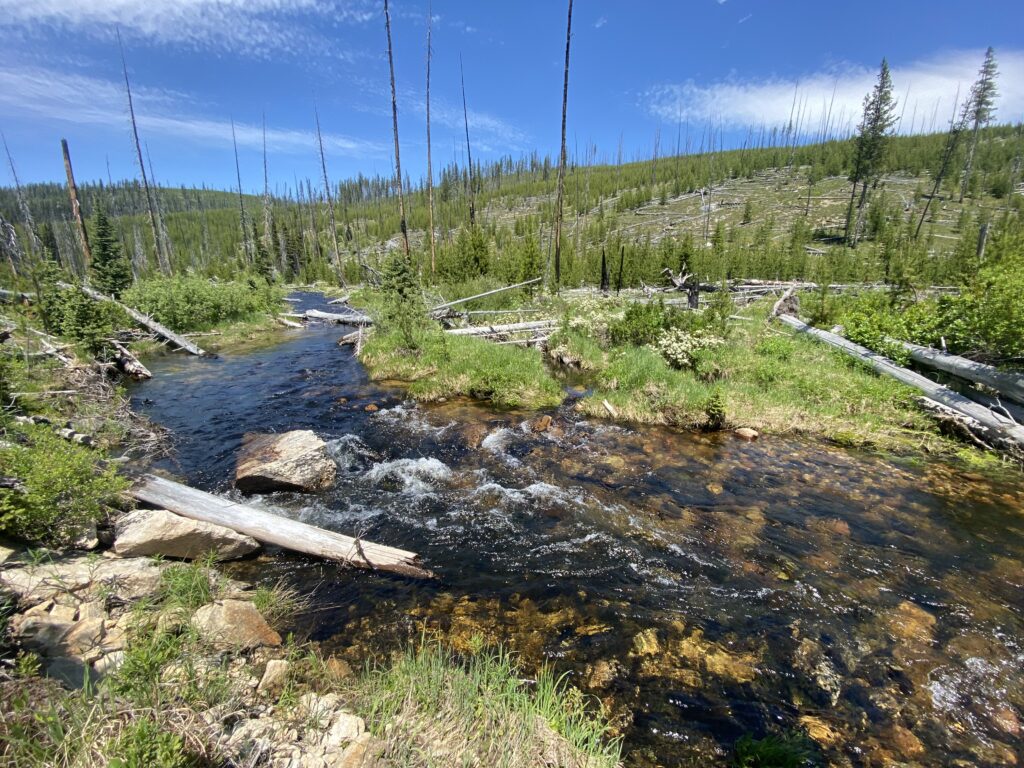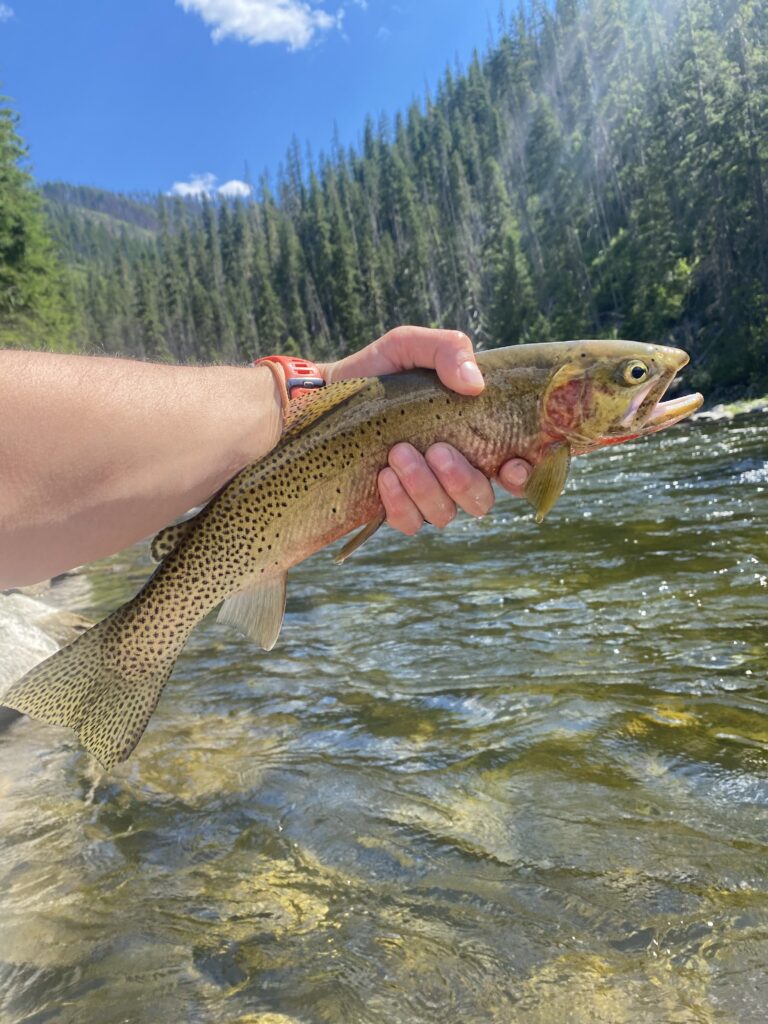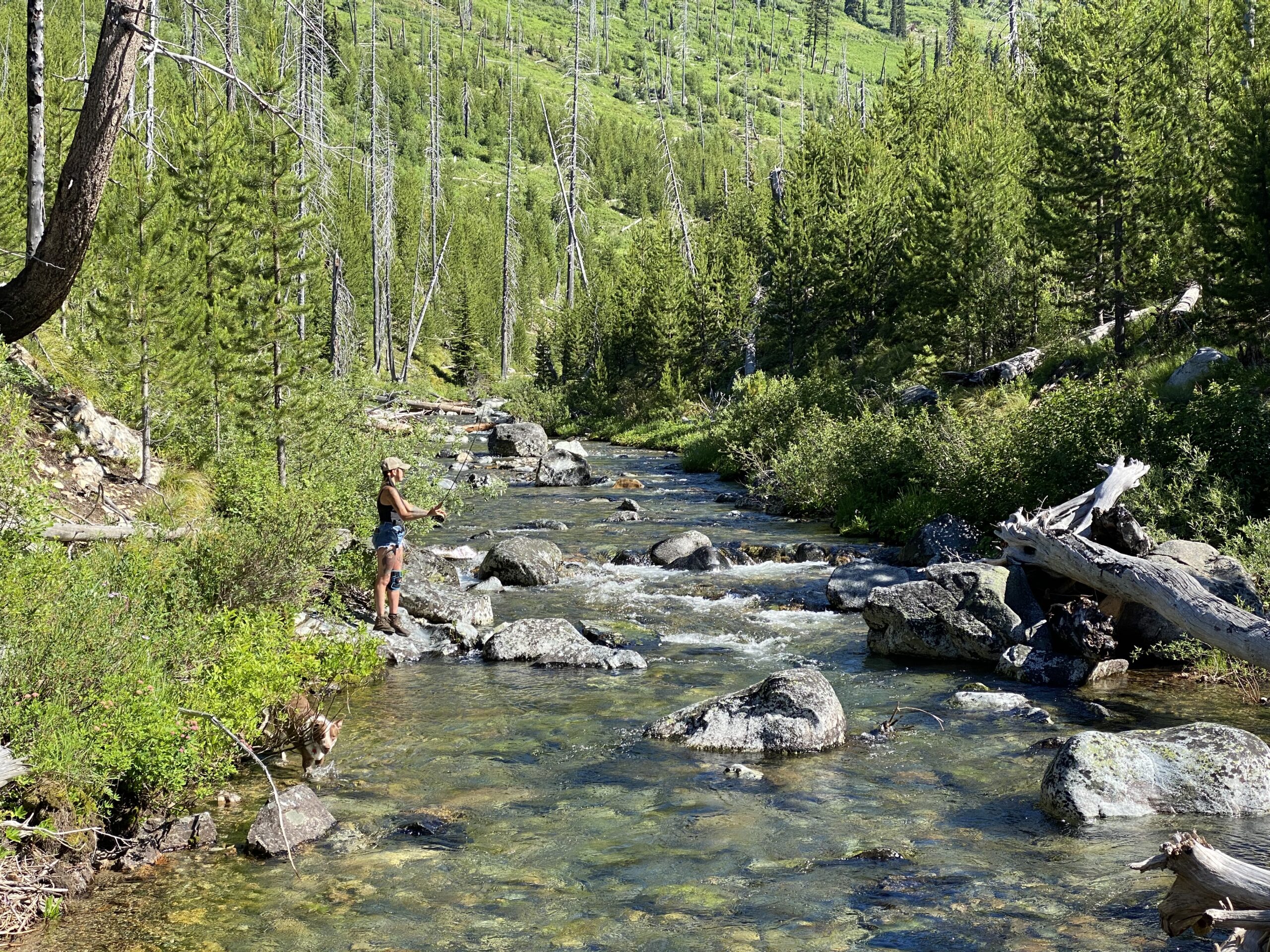There’s a rhythm to summer fly fishing on Idaho’s Lochsa River that you won’t find in many places anymore. It starts with the sound of rushing water and the quiet that comes with zero cell service. Out here, in the forested canyons just beyond Lochsa Lodge, you’re fishing on one of the last wild stretches of river in the lower 48—a place that demands your full attention and rewards you for giving it.
If you’re planning to cast a line in the waters around Lochsa Lodge, you’re in good company. Each summer, seasoned anglers, first-timers, and lodge regulars return to these rivers not just for the fishing, but for the wild beauty and serene nature of this remote stretch of Idaho.

The lodge is home to a crew of knowledgeable fly fishers who’ve spent years learning the ins and outs of the Lochsa and its tributaries. We caught up with Kyle Tripp, a Lochsa Lodge employee and longtime angler, to gather insights about what makes this place so special. Kyle’s tips range from information about summer hatches and river access to gear setups and ethical angling—so you can make the most of your time on one of the West’s most rewarding rivers.
Flying Fishing Lochsa River: A Wild Place to Fish
What sets the Lochsa apart isn’t just the quality of the fishing, it’s also the wild and untamed setting. With dense evergreen forest, steep ridgelines, and wildlife that includes moose, marmots, eagles, and even the occasional mountain lion, the river delivers an experience far beyond the catch.
From June through August, this river is alive with bug activity and trout that are eager to feed on top. You don’t need to hike miles into the backcountry to find success, either. Pullouts along Highway 12 offer quick access to productive water, and within two steps of the road, you’re casting to wild fish in water so clear you can see the take before you feel it.

If solitude is what you’re after, it’s easy to find. Skip the obvious pullout with three cars and drive another mile—you’ll likely have an entire stretch of river to yourself. Kyle says this is one of the reasons this area is so beloved by anglers: “The Lochsa is one of the last areas that you can really escape it all. Limited to no cell service really lets you get away from the troubles of life and allows you to focus purely on the fishing.”
When to Fly Fish the Lochsa River: Early to Late Summer
The fishing season here shifts as summer unfolds. Early on, snowmelt feeds the river, keeping flows strong and temperatures cool. This is the sweet spot: long days where you can fish from morning through evening without worrying about water temps or stressing the fish. Visibility may be slightly stained in some areas, but usually, you can find crystal-clear runs and riffles that are perfect for dry-dropper rigs.
As July gives way to August, the water drops and warms. Mornings and evenings become the best windows, and fish tend to get more wary. Kyle says you’ll want to downsize your tippet from 4x to 5x or smaller, and focus on keeping presentations delicate and natural.
Even in the heat of late summer, the river remains fishable. And with the water levels low and clear, sight-fishing becomes a real treat—watching a cutthroat rise to inhale your fly in crystal clear water is about as good as it gets. As Kyle puts it, “The water will be some of the clearest you will see anywhere in the country, which makes sight fishing very fun.”
The Hatch Menu
The Lochsa’s bug life is consistent and classic. Summer on the Lochsa River is defined by its diverse and active hatches, making it one of the most rewarding times of year to fly fish in these waters. Knowing what’s hatching can make all the difference, from the big bugs of early summer to the steady presence of caddis well into fall. Here’s a breakdown of the key fly hatches you’ll want to keep in mind.
Caddisflies
- Active from June through October
- Reliable presence throughout the season
Salmon Flies
- June to early July
- One of the most exciting early-summer hatches
- Big, splashy strikes from hungry trout
Stoneflies
- Present all summer long
- A consistent option for dry fly enthusiasts
Golden Stones
- Early July through late August
- Often the most productive hatch of the summer
- A go-to dry fly pattern for local anglers
Hoppers
- Peak activity in July and August
- Great for aggressive, surface-feeding Cutthroat
Mayflies
- Steady hatches throughout July
- Best matched with traditional dry fly patterns
Pro tip from Kyle: If you’re not sure what to tie on, you won’t go wrong with a Golden Stonefly pattern during summer months. Big flies can lead to big fish on the Lochsa.
“If you are hell bent on catching a good-sized trout, throw those big bugs. And if all else fails, tie a streamer on, and be patient. You will hook into something good,” says Kyle. And it’s hard to argue when you see what the cutthroat will rise to take in these waters.
Fly Fishing Gear and Approach
You don’t need an elaborate setup to fish the Lochsa successfully. A 5-weight rod is perfect for most trout fishing here. If you’re targeting bull trout later in the summer—or want to swing heavier streamers in deeper holes—bring a 7- or 8-weight.
Use heavier tippet in early summer when flows are high and fish are aggressive. As the season progresses, you’ll need to go lighter to avoid spooking fish in the skinny water. And while waders are handy early on, by July you’ll likely want to wet-wade—cooling your legs in the current while picking apart pocket water and undercut banks.
Before hitting the water, take time to understand the local regulations that help protect the Lochsa’s wild trout population. Barbless hooks are required on the river, and catch-and-release rules apply above the Wilderness Gateway Campground. Downriver, anglers can keep two trout measuring 14 inches or longer, but bull trout are always catch-and-release.
As Kyle advises, “Read the Fishing Planner thoroughly. Keep a copy with you on the water—it’s easy to forget something when you’re focused on catching that trophy fish.” And don’t forget, you can stop by the Lochsa Lodge Country Store and Mercantile for a license, fishing regulations, and limited fishing supplies.
Beyond the Main River
While the Lochsa itself provides more than enough water for a summer’s worth of fishing, its tributaries offer something different: solitude, adventure, and, sometimes, a chance at a bigger fish.
Crooked Fork Creek sees less pressure and holds surprisingly good-sized trout. Colt Killed Creek offers a hike-in experience that gets more rewarding the farther you go—juvenile rainbows near the trailhead give way to trophy-sized fish deeper in.
For alpine stream lovers, a drive up Elk Summit Road opens the door to miles of remote water, including Swamp Creek and Hoodoo Creek—places where brook trout shine in brilliant orange and green, and you may not see another angler all day.

Lodge Life and Local Knowledge
Lochsa Lodge doesn’t offer guided trips, but it does offer something just as valuable: real, local advice. The Country Store across from the main lodge sells just about anything you will need to have a successful fishing trip and is staffed with anglers who fish the river daily. Being an Idaho Fish and Game vendor, they sell fishing licenses and permits for Salmon/Steelhead
“Ask for Mike, Kyle, Boots, or Tristan,” says Kyle, “and all of your fishing questions will be answered, and maybe a few ‘Honey Holes’ revealed.”
The Lochsa Lodge has stood for nearly a century, and with that comes a deep sense of history, stewardship, and community. The lodge naturally serves as a gathering place, where stories, flies, and tips are exchanged over coffee or around the fire pit. Spend an evening here, and you’ll quickly find that the spirit of the Lochsa is as much about the people as it is the river. As Kyle shared with us, “Most people that come here respect the river and the fish that live in it. And that connection really adds to the whole fishing experience. You will see groups of anglers working together, sharing information, flies, tactics and much more with each other. Don’t be shy to ask others what they are using, and how they are using it. Most people will respond with a very friendly and helpful answer.”
Respect the River, Join the Tradition, and Relish the Seclusion
Most anglers here understand what it means to care for a wild fishery: keep fish wet, shorten the fight, skip the grip-and-grin if it’s too hot, and always pack out what you pack in. And perhaps most importantly, give each other space. With so many miles of accessible water, there’s no reason to crowd someone’s spot. Kyle invites anglers to join a long, proud tradition with a healthy respect for its deep roots: “The lodge is almost 100 years old, and with that comes a lot of history. This is our home, and we love it. We all do our best to take care of the river and the surrounding areas. Being outdoor enthusiasts, it is our job to protect and care for our lands if we want to continue to use them.”
Ask around Lochsa Lodge and most folks have a story—a perfect day, a dozen topwater takes in a row, a wild trout that peeled line in a way they didn’t expect. These aren’t stocked fish or manicured streams. This is the Lochsa: fast, free, and full of surprises.
Bring your big bugs, your patience, and your curiosity. The river will take care of the rest.

